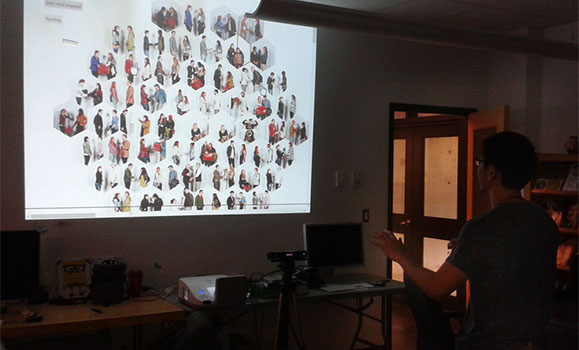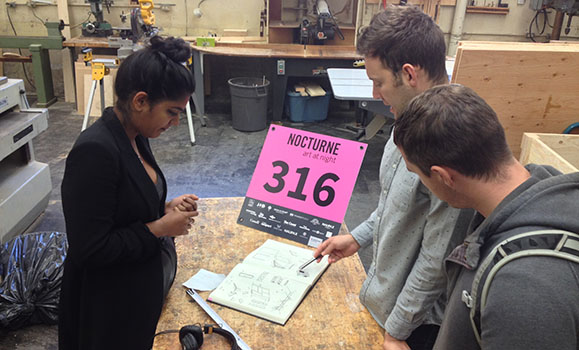If there’s one Halifax night that’s completely unlike any of the other 364 each year, it’s .
Now in its eighth year, the annual arts festival throws open the doors to the city’s art galleries and floods streets and public spaces with installations from local artists of all styles, sensibilities and media. Free for all to attend, the event draws thousands of people to downtown Halifax and Dartmouth each year, creating an energy in the city that’s truly unique and infectious.
And you‚Äôre planning on checking out this year‚Äôs event on Saturday night, you won‚Äôt want to miss a whole suite of H¬ĢĽ≠-linked projects, covering everything from the building of a real-time social network to a chance to create architectural ideas for one of Halifax‚Äôs downtown institutions.
Social networks at the Central Library
One of the hottest Nocturne destinations is certain to be the Halifax Central Library, given that it‚Äôs the first year the new building has been part of the festival. And it‚Äôs there that visitors will find two of H¬ĢĽ≠‚Äôs installations.
The first involves someone whose work will be quite familiar to regular Nocturne attendees: Derek Reilly, assistant professor in H¬ĢĽ≠‚Äôs Faculty of Computer Science. This will be the fourth Nocturne for Dr. Reilly and his students, who each year bring a unique activity that explores human-computer interaction. (The installations are meant to provide research insights to the team.) Their past installations have included a human ‚Äúpong‚ÄĚ game and an interactive video game linking Twitter and Tetris ‚ÄĒŐż‚ÄúTweetris‚ÄĚ ‚ÄĒŐżwhich won the festival‚Äôs first Artist Award in 2012.
This year’s project is called and builds on a 2014 Nocturne installation by photographers Damian Lidgard, órla MacEachern and Hannah Minzloff. Last year, at the Canadian Museum of Immigration at Pier 21, the trio photographed over 500 strangers interacting for the first time.
This year, the photographers have teamed with Dr. Reilly and his students at the Graphics and Experiential Media (GEM) Lab to add a digital component to the project. At the pop-up studio in the Halifax Central Library, strangers will be photographed meeting for the first time. Those portraits will be showcased on a large, interactive digital display, and attendees will be able to manipulate the images to draw connections with people they know or recognize.

‚ÄúThe idea is that eventually some of those strangers will end up having those friend-of-a-friend relationships. When the system does that, the honeycombs will glow, with animations showing the map of relationships that link those people together,‚ÄĚ says Dr. Reilly, whose project involves the work of several postdocs, graduate students and undergrads.
‚ÄúWe‚Äôre focused on the notion that everyone knows everyone here, or knows someone else. We‚Äôre a very close-knit community. That‚Äôs what we‚Äôre testing in real time.‚ÄĚ
A song of time
For something more musical, the Central Library is also host to an installation that‚Äôs been put together by the Fountain School of Performing Arts‚Äô Society of H¬ĢĽ≠ Music Students. Titled the piece is an exploration of Halifax‚Äôs history through video and a live orchestra.
‚ÄúIt‚Äôs large-scale immersive multimedia experience,‚ÄĚ says Andrew Coll, a fifth-year Music student and one of the core team behind the project. ‚ÄúThere‚Äôs going to be an orchestra, video projection, lighting effects. It‚Äôs a big production but it‚Äôs a personal story of an elderly woman as she looks back on her life.‚ÄĚ
While a work of fiction, the woman‚Äôs story that forms the core of the video/musical piece is inspired by Coll‚Äôs grandmother, who lived in Halifax all her life and was a nurse in the Second World War. Coll and his collaborators (Brendan Mott, Craig Laing and Julia LeBlanc, all Dal students or grads) use the woman‚Äôs story as a way to explore Halifax‚Äôs history through music. The piece, which received funding as one of Nocturne‚Äôs 16 ‚Äúbeacon‚ÄĚ projects this year, will feature 50 musicians, performing the 45-minute piece in shifts in the library‚Äôs Paul O‚ÄôRegan Hall throughout the evening.
Őż
‚ÄúI‚Äôve loved Nocturne since the very beginning,‚ÄĚ says Coll. ‚ÄúThe fact we‚Äôve been able to do this project and bring it to the people of Halifax is an incredible honour and it‚Äôs incredible to be a part of.‚ÄĚ
Innovative ideas for classic spaces
Meanwhile, just next door on Dal‚Äôs Sexton Campus, Nocturne attendees will find two more H¬ĢĽ≠ projects to explore.
The first, titled is an interactive exhibition that allows attendees to experience a taste of what it‚Äôs like to be an Architecture student ‚ÄĒŐżand make their mark on a Halifax landmark.
‚ÄúWe took the theme of ‚Äėlost and found‚Äô and put an Architecture student lens on it,‚ÄĚ says Mark White, a master‚Äôs student and part of the team with the H¬ĢĽ≠ Architectural Student Associations behind the installation. ‚ÄúA lot of the time we work with trace paper, where with each trace your project is becoming something more than a piece of paper and an idea. And we wanted to apply that in a city context.‚ÄĚ

‚ÄúLiving Traces‚ÄĚ involves a vertical light wall, on which attendees can do their own tracing over a view of the old Halifax library across the street. ‚ÄúSo on the light wall, we have images, plans of the old libraries, audience can come in, rip off the sheet of trace and make their own mark on this building and what they want to see happen to it,‚ÄĚ says White.
‚ÄúIt‚Äôs a really interesting way for us to engage with the public in a way that‚Äôs different.‚ÄĚ
And while you‚Äôre on Sexton Campus, don‚Äôt miss an installation also at the School of Architecture hosted by the Dal-linked #PlayMeHfx initiative in collaboration with the H¬ĢĽ≠ Architecture Students Association, the H¬ĢĽ≠ Society of Undergraduate Planners and the H¬ĢĽ≠ Undergraduate Engineering Society. It features a ‚Äúmagical‚ÄĚ grove of trees, hidden on Sexton Campus, where curiosity is rewarded in unexpected ways: check out the red swings, twinkling starlights, hot lemonade and playful pianos.
Finally, swing by the H¬ĢĽ≠ Art Gallery on Studley Campus for originally two separate projects but brought together at the gallery. Both exhibitions feature contemporary artwork produced as ‚Äėoutputs‚Äô of biomedical readings of human subjects. In Delva‚Äôs case, the participating body is his own; Phillips, on the other hand, provides artwork and an interactive video installation from her on-going polygraph tests with over 350 international artists and art collaborators.
Nocturne Halifax runs from 6 p.m. until midnight, all across Halifax and Dartmouth. For more information, .

